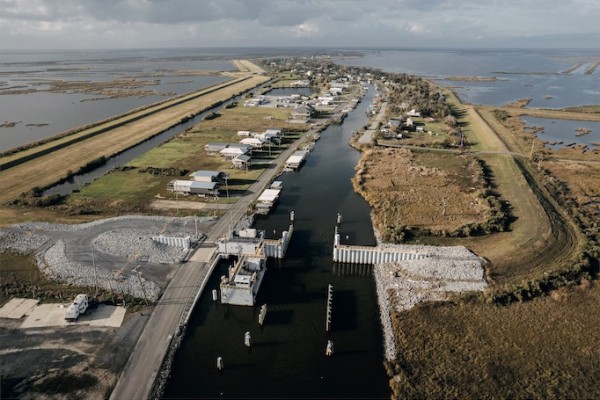Photo exhibit showcases forgotten histories of Pointe-au-Chien’s native tribe
29th April 2024 · 0 Comments

A photo from the series, “Mon Coeur est dans la terre de Ma Famille,” an exhibit documenting the daily life and culture of the Pointe-au-Chiene Indian Tribe of Terrebonne Parish. | Photo by Wayan Barre
By Makenna Mincey
Contributing Writer
As part of a celebration of Francophone culture, South Louisiana’s French-speaking Pointe-Au-Chien Indian Tribe have become the subject of a photo documentary project showcasing their lives, heritage and culture.
Photographed and curated by photographers Audoin de Vergnette and Wayan Barre, the exhibit, “Mon Coeur est dans la terre de Ma Famille,” is on display at the Alliance Française of New Orleans (AFNO) until June.
The exhibit – a set of vibrant and reverential images depicting the community’s youth and elders, landscapes and waterways, and daily life – was commissioned by the Consulate General of France in New Orleans and the Cultural Services of the French Embassy in the United States in celebration of a revival of French language in Louisiana.
De Vergnette, a former photojournalist and current press attaché for the Consulate General of France in New Orleans, said the purpose of the exhibit is to showcase the lives of the Francophone indigenous people of South Louisiana and honor their heritage and legacy. “We wanted to show the culture and life of such a strong and resilient community that is such a unique part of the Louisiana French-speaking world,” he said in an Instagram post announcing the exhibit.
Even the exhibit’s name, which translates to “My Heart is in the Land of My Family,” is rooted in the tribe’s cultural identity and history. The exhibit’s name is taken from a verse of a song chanted by children at the Pointe-aux-Chenes cultural summer camp; each verse of the song recounts a different part of the tribe’s history.
Following its stint at AFNO, “Mon Coeur” will be placed on permanent display at École Pointe-au-Chien elementary school in Terrebonne Parish, which opened its doors in August of 2023 as the first French immersion school serving a predominantly indigenous population. Standard and Louisiana French are both a part of the school’s curriculum. Enrollment is open to students in Terrebonne and Lafourche parishes.
While de Vergnette’s work has showcased much of Louisiana’s French heritage, Barre has been working to document the region’s marginalized communities – particularly those facing environmental and social inequities. “This project is the longest I’ve been working on so far, going back and forth for more than a year,” Barre said. “The level of intimacy and friendship I developed with several members of this community is very high.
“Since this project, I have considered respect, curiosity and patience the most important aspects of making a compelling story,” Barre said.
Today, more than 800 members of the Pointe-au-Chien tribe still reside on the land of their ancestors. Over the years, they have faced education, economic and healthcare discrimination dating back to the early 1900s. In addition to being segregated from non-Native communities for about the first half of the 20th century, they were also not allowed to attend high school until the late 60s through the early 70s.
Christine Verdin, a member of the Pointe-aux-Chien Tribal Council and the executive director of École Pointe-au-Chien, said the exhibit will only enhance the good will and work the school brings to the tribe. “Our photo exhibit means that our story is being seen by people who view the exhibit. It depicts our community and the people who live there,” she said.
“The school is a big bonus to this community. People feel that it’s a great way of keeping our language alive and hopefully bridging the gap between grandparents and kid[s],” Verdin explained. “There are two generations of people who have lost the language. Our hope are [sic] that through night classes, those generations will learn French and that we will see and listen to more French being spoken amongst younger people.”
In addition to language loss, the South Louisiana tribe is also experiencing land loss.
Both environmental and man-made factors, like lack of barrier islands and levees to protect their communities, have made the area extremely susceptible to flooding. This has caused tribe members to take drastic steps, such as raising their houses to heights of 13 feet. The project was able to shed light on these issues as well, raising much needed awareness and visibility for the community.
“With the help of scientists, researchers, landscapers, geologists, lawyers, activists, and volunteers, the tribe is looking for ways to fix the past and prepare for the future,” Barre said of the importance of exhibits that call attention to their community.
“This documentary tells the story of the unprecedented crises and the constant efforts to protect homes as well as traditions. Furthermore, what this community is experiencing today could give us a clue of tomorrow’s challenges,” Barre said.
The Pointe-au-Chien tribe received state recognition in June 2004 but still has not received their federal recognition. As they still fight for this recognition, the photographers hope that visual storytelling such as this exhibit will keep the story at the forefront.
“I did my best to capture the atmosphere of Pointe-au-Chien and its surroundings. The human aspect was also a very important driver when I was sequencing the photographs,” Barre said.
Verdin too hopes that “Mon Coeur” will elevate the visibility of the tribe, its history and heritage, and the challenges the community is facing.
“I hope this allows people to see how important our culture is to us and how important it is to preserve our heritage as much as we possibly can. The photos of the water, boats, landscape, show the good things in our community. However, it also shows the bad things that are slowly changing,” Verdin said.
For more information about École Pointe-au-Chien or the exhibit, visit www.ecolepointeauchien.org.
This article originally published in the April 29, 2024 print edition of The Louisiana Weekly newspaper.



